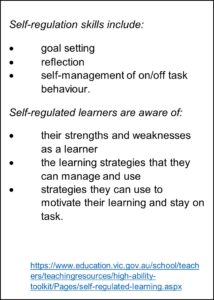ENCOURAGING SELF-REGULATION IN YOUR CHILD’S LEARNING

In reflections of the COVID remote learning era, educational experts focusing on the positive gains of this unplanned diversion in schooling have been quick to identify that remote classrooms which emphasised student-centred lessons and encouraged self-regulation achieved better outcomes during this time (Hattie, 2021).
At Greenvale, we are continuing on the learnings of this experience and fostering an environment in which students can become independent, self-aware and assessment-capable learners. It has been wonderful to see our students grow this semester in their ability to articulate their learning achievements and challenges, discussing their progress, growth and goals with a range of peers and adults during the school day.
Self-regulated learning is best achieved via shared partnership between the child, the school and the family. We encourage families to continue to build learner-awareness outside of the school day through conversation with their children about their learning at home. Below are some areas of classroom practice that can be used to create productive shared discussion about your child’s learning at home.
FEEDBACK
The purpose of feedback is not to ‘fix the work’ but to ‘improve the learner’. Feedback practices that are individualised and student-centred are effective in fostering student self-regulation (Brooks et al., 2021), but to achieve this students need to engage with the advice given. Feedback is provided throughout the GSC Assessment Cycle in a number of ways, including verbally, on written work and through the task rubric on OneNote.
You can look at OneNote with your child at different points in the school term to read and discuss ‘Strengths’ and ‘Strategies for Improvement’ outlined by the teacher for Milestone Tasks and CATs. Ask open-ended questions about student work such as ‘What are you most proud of from this task?’, ‘How did you deal with the challenges?’ and ‘What strategies can you use in the next two weeks to act on your teacher’s suggestions?’. As part of these discussions, students can also edit or add to the Student Self Reflection and Goal Setting section of their rubrics.
LEARNING INTENTIONS AND SUCCESS CRITERIA
As part of our G5 Instructional Model, every lesson at GSC begins with the discussion of a shared Learning Intention and the Success Criteria that will indicate achievement of the learning. When students know what success looks like, they are more likely to set goals and acquire a sense of how to judge their own progress. They recognise that they have something to learn and what it looks like when they have learned it (Fisher et al., 2019).
The opportunity to revisit their learning outside of the school day promotes reflection, encourages connections between lessons and increases student exposure content and language they have covered.
You can log on to Compass with your child and click on their timetable to view the Lesson Plans for previous or upcoming lessons. Ask your child to explain the Learning Intentions in their own words, and how this came to life in the classroom. Revisit the Success Criteria and ask your child to identify if they achieved them- using a ‘Confidence Scale’ of 1 to 5 for each criteria can be a useful tool to identify what has been mastered and what needs focus moving forward.
LEARNER LANGUAGE
Our 10 Learner Language words have been selected and defined by GSC students as a way of a having a shared vocabulary with which to discuss our learning. The words will be displayed around classrooms at GSC to provide students with a verbal toolbox to express their learning achievements and challenges.
You can use the GSC Learner Language as part of your conversations with students about their learning at home and encourage them to apply these words in both formal and informal reflections about their progress.
Hattie, J. (2021, May 1). What Can We Learn from COVID-Era Instruction? ASCD. https://www.ascd.org/el/articles/what-can-we-learn-from-covid-era-instruction
Brooks, C., Burton, R., van der Kleij, F., Carroll, A., Olave, K., & Hattie, J. (2021). From fixing the work to improving the learner: An initial evaluation of a professional learning intervention using a new student-centred feedback model. Studies in Educational Evaluation, 68(68), 100943. https://doi.org/10.1016/j.stueduc.2020.100943
Fisher, D., Frey, N., Amador, O., & Assof, J. (2019). The teacher clarity playbook : a hands-on guide to creating learning intentions and success criteria for organized, effective instruction ; Grades K-12. Corwin, A Sage Company.